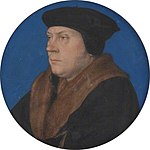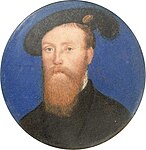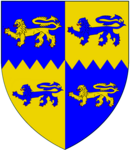Portrait of Johann von Schwarzwaldt
| Portrait of Johann von Schwarzwaldt | |
|---|---|
 | |
| Artist | Hans Holbein the Younger |
| Year | 1543[1] |
| Medium | tempera on parchment[1] |
| Dimensions | 5.4 cm (2.1 in)[2] |
| Location | Pushkin State Museum of Fine Arts, Moscow[3] |
| Website | pushkinmuseum |

Portrait of Johann von Schwarzwaldt is a tempera on parchment portrait completed in 1543 by German artist and printmaker, Hans Holbein the Younger. The painting shows a young man against a blue background, turned three-quarters to the viewer's right. The sitter is wearing a deep black velvet cap and a black silk gown, a shade lighter, with a finely embroidered white shirt showing at the neck and wrist. The eyes are lowered, half covered by the lids, the arms folded. He has two rings on his left hand and is holding leather gloves. There is a flanking inscription at head height —· ANNO · ETATIS // SVÆ · 24 · 1543· — indicating that he was born about 1519.[5] The subject of this portrait was identified as a Danzig merchant, Hans (Johann) von Schwarzwald (1513 − 1575), but his age does not match the inscription.[6] It has been suggested that the young man might be Gregory Cromwell, 1st Baron Cromwell, the son of Henry VIII's chief minister, Thomas Cromwell, 1st Earl of Essex.[7]
Identification[edit]
In 1903 Sir Richard Holmes identified a portrait of a young man, one of a number of portrait miniatures of English origin in the possession of the Queen of the Netherlands, as the work of Hans Holbein the Younger.[8] He suggested that the unidentified youth "apparently of fifteen or sixteen years of age" might possibly be one of the family of a Hanseatic merchant of the Steelyard in London "like the admirable head of Derek Born".[8][9] Art historian Roy Strong has dated the portrait to c. 1535–1540.[10]
The sitter has hooded eyes and his hair is close cropped as seen in Portrait of a man, probably Sir George Carew (c. 1540), Portrait of an Unknown Man, possibly identifiable as Thomas Seymour (c. 1535–1540) and Portrait of William Parr, Marquess of Northampton (c. 1538–1542). The sitter's clothing is distinctly English and George Williamson noted that "as it finds its place in a collection which includes many miniatures by English masters, such as Cooper, Oliver, and Hoskins, it may be thought possible that the picture was painted in England, and represents perhaps some young Englishman of notable position".[11] Arthur Chamberlain observed that his features "appear more English than German, and that it most probably represents the son of some personage about Henry's court."[12]
-
Derich Born, c. 1533
-
Portrait of a man, probably Sir George Carew, c. 1540
-
Portrait of an Unknown Man, possibly identifiable as Thomas Seymour, c. 1535–1540
-
William Parr, later Marquess of Northampton, c. 1538–1542
In 1913 Georg Habich discovered another portrait miniature of an unknown young man by Hans Holbein the Younger in the Danzig Stadtmuseum.[13] The miniature was first recorded in the museum's collection in 1902.[14] There was a tradition in Danzig that the subject was a member of the Schwarzwald family.[15] In 1708, after the male line of the Schwarzwald family had died out, the portrait, together with a library and a coin collection, formed part of a legacy left to the church of Saints Peter and Paul in Danzig.[15] The inscription — ANNO ETATIS // SVÆ 24 1543 — indicates that the sitter was twenty-four in 1543 and consequently born circa 1519.[16] The sitter has hooded eyes and a turned up nose; his clothing is English, with a pointed tasselled collar as seen in English portraits of the period, for example, Portrait of a man, probably Sir George Carew (c.1540). The portrait was looted from the Danzig Stadtmuseum by the German occupation forces in 1943, then claimed by the Soviet Union's Red Army as spoils of war in 1945.[17][1] The portrait, now held at the Pushkin State Museum of Fine Arts in Moscow, is one of a number of works of art subject to restitution requests by the Polish government.[17][18][19]
Habich identified the sitter as the merchant, Heinrich von Schwarzwald (8 July 1517−1561), the eldest son of Hans I (Johann) von Schwarzwald (1468–1521) by his third wife, Margarethe von Reesen, but Heinrich's age does not match the inscription, nor does the "Z or very widely placed N" on the signet ring correspond to his merchant's mark or the Schwarzwald coat of arms.[20] None of the Steelyard merchants who were painted by Holbein have a merchant's mark on a signet ring, only a coat of arms: for example, The Merchant George Gisze (1497-1562) (on the table) and Hermann von Wedigh III (died 1560) (on his index finger).[21]
-
The merchant George Gisze (1497-1562), 1532
-
Hermann von Wedigh III (died 1560), 1532
-
Siebmacher's Wappenbuch bd. 5., S. 175
Hans Secker claimed that by tradition the sitter was known as Hans II (Johann) von Schwarzwald (13 June 1513−1575), the eldest son of Hans I (Johann) von Schwarzwald (1468–1521) by his second wife, Margarethe Cölmer, but Heinrich's older half-brother, who was born in 1513, is around six years older than the subject of the painting.[6][22] Heinrich's younger brother, Berend, who reached the age of 24 only on 21 September in 1543, shortly before Holbein's death and during an outbreak of plague, is unlikely to be the sitter.[23][24][25] In 1543 there was a "great death" in London, which lasted so far into the winter that the Michaelmas law term had to be kept at St. Albans. Another civic chronicle adds that there had been a great death in the summer before; and from an ordinance of the Privy Council it appears that the plague was in London as early as 21 May 1543. Hans Holbein died between 7 October, when he made his will at his home in Aldgate, and 29 November 1543, when John of Antwerp carried out the artist's last wishes.[26]
The year 1543 is significant for two reasons: Henry VIII married his sixth wife, Catherine Parr and the "King's painter", Hans Holbein died.[27] The portrait miniature of the 24-year-old man has a special significance in that it may have been the artist's last work.[28]
In 2003 Quentin Buvelot noted that "On the basis of the similarity of facial features and in particular the characteristic angle of the cropped hair, it could even be conjectured that the two portraits depict the same person."[29] In the same year the sitter was identified as Hans II Schwarzwaldt (1513–1575), the son of merchant Hans I Schwarzwald (1468–1521), based on a very strong resemblance to the subject of the other portrait miniature painted by Holbein in 1543 and since only he was at that time in the Steelyard in London.[30] Hans II (Johann), however, was 30 years of age in 1543, not 24.
According to Roy Strong the existence of a second miniature indicates a sitter of exceptional importance: royal personages and near-relations.[31][32] In 2016 Teri Fitzgerald and Diarmaid MacCulloch suggested that the sitter might be Henry VIII's brother-in-law, Gregory Cromwell (c.1520–1551), son of the king's chief minister, Thomas Cromwell.[7] Gregory Cromwell married, in 1537, Elizabeth Seymour, the widow of Sir Anthony Ughtred (d. 1534) and a younger sister of Queen Jane Seymour, Henry VIII's third wife.[33] The subsequent birth of a prince also meant he was an uncle to the future Edward VI.[33] Gregory, who was born in or before 1520, was the right age and of suitable status to be the subject of the portraits.[16][34][35] There is every likelihood that a miniature of Thomas's son Gregory would have been painted around the time of his marriage, "when both father and son had so much to celebrate."[36] It is of interest to note that, in Cromwell's accounts for 1538, there is a payment on 4 January to "Hanns the painter, 40s."[37]
-
Thomas Cromwell, Earl of Essex, c. 1532–1533
-
Thomas Cromwell, Earl of Essex, c. 1537
-
Portrait miniature of a gentleman, possibly Charles Brandon, Duke of Suffolk, c. 1532
-
Portrait miniature of a gentleman, possibly Charles Brandon, Duke of Suffolk, c. 1532
-
Thomas Seymour, Baron Seymour of Sudeley, c. 1545 –1547
-
Coat of arms of Gregory Cromwell, 1st Baron Cromwell
The young man's features "have a distinct resemblance" to those of his father and he has the "same characteristic Cromwell upturned nose."[38] The "Z or N detail on the signet ring" in the 1543 portrait can be accounted for by Gregory Cromwell's coat of arms, "if it is seen as a zig-zag, or in heraldic terms, a fess indented."[39] Two portrait miniatures of Gregory's brother-in-law, Thomas Seymour, from the 1540s are extant:Thomas Seymour, Baron Seymour of Sudeley (c. 1545–1547) at the National Maritime Museum, London and Thomas Seymour, Baron Seymour of Sudeley, (c. 1540), attributed to Lucas Horenbout in the Royal Collections, The Hague.[40]
See also[edit]
References[edit]
- ^ a b c "Portrait of Johann von Schwarzwaldt". The Division for Looted Art. Warsaw: Ministry of Culture and National Heritage. Retrieved 13 June 2023.
- ^ Fitzgerald & MacCulloch 2016, p. 599.
- ^ Fitzgerald & MacCulloch 2016, pp. 598–599.
- ^ "Portrait Miniature of Hans Schwarzwaldt". Koninklijke Verzamelingen. The Hague. Retrieved 1 June 2023.
- ^ Fitzgerald & MacCulloch 2016, pp. 599–600.
- ^ a b Secker 1913, pp. 26–27.
- ^ a b Fitzgerald & MacCulloch 2016, pp. 587–601.
- ^ a b Holmes 1903, pp. 218–219.
- ^ Schaffers-Bodenhausen & Tiethoff-Spliethoff 1993, p. 373 (cat. 492).
- ^ Strong 1985, p. 51.
- ^ Williamson 1904, pp. 10–11.
- ^ Chamberlain 1913, pp. 229–230.
- ^ Habich 1913, pp. 194–196.
- ^ Jackowska 2016, pp. 69–70.
- ^ a b Habich 1913, p. 195.
- ^ a b The sitter was 24 between 25 March 1543 and Holbein's death. In England, until 1752, the year commenced on 25 March, Lady Day.
- ^ a b Fitzgerald & MacCulloch 2016, pp. 598–600.
- ^ BAT, (PAP) (17 May 2013). "Polska chce od Rosji zwrotu 18 dzieł sztuki". Nowy Dziennik, Polish Weekly. Archived from the original on 1 November 2019. Retrieved 23 May 2022.
- ^ "Poland's Culture Minister Bogdan Zdrojewski Seeks Return of Art Seized by Soviet Russia in 1945". Artdaily.cc. 16 May 2013. Retrieved 23 May 2022.
- ^ Rowlands 1985, p. 152 (m. 14) and pl. 139.
- ^ Petter-Wahnschaffe 2010, pp. 114, n. 750 (p. 287).
- ^ "Schwartzwald". Genealogische Tafeln zu Familien aus Danzig sowie aus Westpreußen und Hinterpommern. Verein für Familienforschung in Ost- und Westpreußen. 2020. (in German)
- ^ Weichbrodt 1986, p. 459: "er hat für d. Holbein'sche Bild das richtige Alter" (He's the right age for Holbein's picture)"
- ^ Petter-Wahnschaffe 2010, pp. 114, n. 755 (p. 288).
- ^ Moyle 2021, p. 536: "But just three days after the king's sixth marriage a panicked court issued a proclamation forbidding Londoners from 'entering the gates of any house wherein the King or Queen lie, and forbidding servants of the Court to go to London and return again'. The same declaration was 'Forbidding (considering the peril of infection) persons who inhabit London and its suburbs not being King's household servants or necessary for provision of his household, from resorting to Court'."
- ^ Wilson 2006, p. 277.
- ^ Strong 1985, p. 38: "Catherine Parr had a passion for miniatures which we find reflected in a letter dated 17 May 1547 from her husband-to-be, Thomas Seymour, Lord Seymour of Sudeley".
- ^ Fitzgerald & MacCulloch 2016, pp. 598, 601: "What more natural, then, that in 1543 Holbein should paint a portrait of this living symbol of England’s evangelical Reformation when undertaking his last round of English portraiture in the circle of Henry VIII’s last queen, herself a convert to the evangelical cause?"
- ^ Buck & Sander 2003, p. 138.
- ^ "Portretminiatuur van Hans Schwarzwaldt". Koninklijke Verzamelingen. The Hague. Retrieved 24 May 2022.
In het verleden dacht men ook aan de mogelijkheid dat de geportretteerde Heinrich Schwarzwald betrof maar in feite kan het alleen Hans Schwarzwald II zijn (zoon van koopman Hans Schwarzwald I uit Gdansk) zijn aangezien alleen hij zich op dat moment bevond in de Stahlhof in Londen. [In the past it was also thought that the portrayed was Heinrich Schwarzwald but in fact it can only be Hans Schwarzwald II (son of merchant Hans Schwarzwald I from Gdansk) as only he was at that time in the Stahlhof in London.]
- ^ Strong 1983, p. 38 (?Charles Brandon).
- ^ Strong 1985, p. 34: "The sitters can be plotted across a family tree of the Tudor dynasty and its collaterals."
- ^ a b Fitzgerald & MacCulloch 2016, p. 593.
- ^ Fitzgerald & MacCulloch 2016, p. 590: "Gregory was significantly younger than twelve in 1529, and the nature of his educational programme projects the date of his birth back to 1519 or 1520."
- ^ MacCulloch 2018, p. 36.
- ^ Fitzgerald & MacCulloch 2016, pp. 595–597.
- ^ Fitzgerald & MacCulloch 2016, pp. 596–597.
- ^ Fitzgerald & MacCulloch 2016, p. 596.
- ^ Fitzgerald & MacCulloch 2016, pp. 600–601.
- ^ Schaffers-Bodenhausen & Tiethoff-Spliethoff 1993, p. 373 (cat. 493).
Bibliography[edit]
- Buck, Stephanie; Sander, Jochen (2003). Hans Holbein the Younger, 1497/98-1543: Portraitist of the Renaissance. Catalogue for the exhibition, Hans Holbein 1497/98-1543, 16 August–16 November 2003. Essays, Stephanie Buck, Jochen Sander; catalogue, Ariane van Suchtelen, Quentin Buvelot, Peter van der Ploeg; with appendices by Bieke van der Mark and Epco Runia. The Hague: Royal Cabinet of Paintings Mauritshuis. p. 138 (cat. 35), ill., 1 pl. (col.). ISBN 904008906X.
- Chamberlain, Arthur B. (1913). Hans Holbein the Younger. Vol. II. London: George Allen & Company.
- Fitzgerald, Teri; MacCulloch, Diarmaid (2016). "Gregory Cromwell: Two Portrait Miniatures by Hans Holbein the Younger". The Journal of Ecclesiastical History. 67 (3): 587–601. doi:10.1017/S0022046915003322.(subscription required)
- Habich, Georg (1913). "Ein Miniature Bildnis von Hans Holbein in Danzig". Zeitschrift für Bildende Kunst. Neue Folge. 24: 194–196, pl. 1. (in German)
- Holmes, Richard R. (April 1903). "An Unpublished Miniature by Holbein in the Possession of the Queen of Holland". The Burlington Magazine for Connoisseurs. 1 (2): 218–219. JSTOR 855585.
- Jackowska, Krystyna (2016). "Bibliofil Heinrich Schwarzwald i jego Portret" [Bibliophile Heinrich Schwarzwald and his portrait] (PDF). Libri Gedanenses: Yearbook of the Gdańsk Library of the Polish Academy of Sciences. 33: 68–85. (in Polish)
- MacCulloch, Diarmaid (2018). Thomas Cromwell: A Life. London: Allen Lane. ISBN 9780141967660.
- Moyle, Franny (2021). The King's Painter: The Life and Times of Hans Holbein. London: Head of Zeus. ISBN 9781788541206.
- Petter-Wahnschaffe, Katrin (2010). Hans Holbein und der Stalhof in London. München: Deutscher Kunstverlag. pp. 113–116. ISBN 9783422069527. (in German)
- Rowlands, John (1985). Holbein: The Paintings of Hans Holbein the Younger (complete ed.). Oxford: Phaidon. ISBN 0714823589.
- Schaffers-Bodenhausen, Karen; Tiethoff-Spliethoff, Marieke (1993). The Portrait Miniatures in the Collections of the House of Orange-Nassau. Zwolle: Wanders. p. 373. ISBN 9789066302624.
- "Schwartzwald". Genealogische Tafeln zu Familien aus Danzig sowie aus Westpreußen und Hinterpommern. Verein für Familienforschung in Ost- und Westpreußen. 2020. (in German)
- Secker, Hans Friedrich (1913). Führer durch die Öffentlichen Kunstsammlungen in Danzig. Bd. 1: Die Städtische Gemäldegalerie im Franziskanerkloster. Danzig: [Stadtmuseum]. pp. 26–27, 1 pl. OCLC 899833120. (in German)
- Strong, Roy (1983). Artists of the Tudor Court: The Portrait Miniature Rediscovered, 1520–1620. Catalogue of an exhibition held at the Victoria & Albert Museum, 9 July–6 November 1983. London: Victoria & Albert Museum. ISBN 0905209346.
- Strong, Roy (1985). The English Renaissance Miniature (revised ed.). London: Thames & Hudson. ISBN 9780500273364.
- Weichbrodt, Dorothea (1986). Patrizier, Bürger, Einwohner Der Freien Und Hansestadt Danzig in Stamm- Und Namentafeln Vom 14.-18. Jahrhundert. Bd. 1. Klausdorf/Schwentine: Rosenberg. OCLC 180573477. (in German)
- Williamson, George Charles (1904). The History of Portrait Miniatures. Vol. I. London: George Bell and Sons. pp. 10–11, pl. III, figs 1, 4. OCLC 1152830751.
- Wilson, Derek (2006). Hans Holbein: Portrait of an Unknown Man (revised ed.). London: Pimlico. ISBN 0714823589.
External links[edit]
- Portrait of Johann von Schwarzwaldt Pushkin State Museum of Fine Arts, Moscow
- Portrait Miniature of Hans Schwarzwaldt Royal Collections, The Hague














